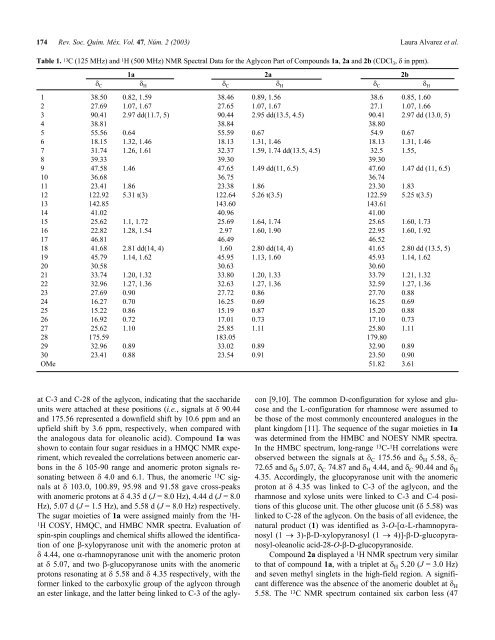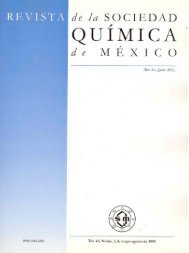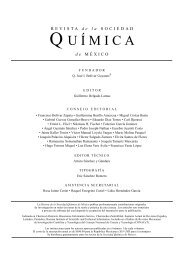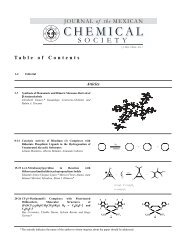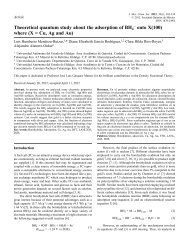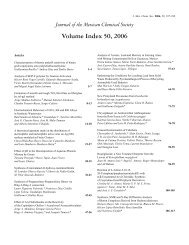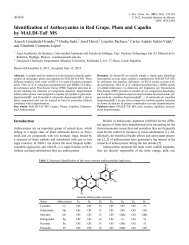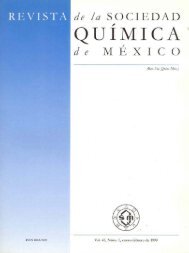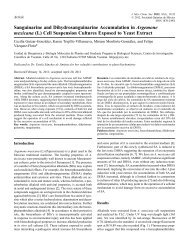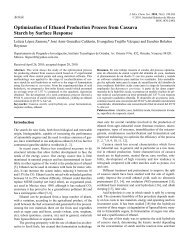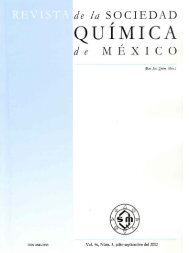SMQ-V047 N-002_ligas_size.pdf - Journal of the Mexican Chemical ...
SMQ-V047 N-002_ligas_size.pdf - Journal of the Mexican Chemical ...
SMQ-V047 N-002_ligas_size.pdf - Journal of the Mexican Chemical ...
Create successful ePaper yourself
Turn your PDF publications into a flip-book with our unique Google optimized e-Paper software.
174 Rev. Soc. Quím. Méx. Vol. 47, Núm. 2 (2003) Laura Alvarez et al.<br />
Table 1. 13 C (125 MHz) and 1 H (500 MHz) NMR Spectral Data for <strong>the</strong> Aglycon Part <strong>of</strong> Compounds 1a, 2a and 2b (CDCl 3 , δ in ppm).<br />
1a 2a 2b<br />
δ C δ H δ C δ H δ C δ H<br />
1 38.50 0.82, 1.59 38.46 0.89, 1.56 38.6 0.85, 1.60<br />
2 27.69 1.07, 1.67 27.65 1.07, 1.67 27.1 1.07, 1.66<br />
3 90.41 2.97 dd(11.7, 5) 90.44 2.95 dd(13.5, 4.5) 90.41 2.97 dd (13.0, 5)<br />
4 38.81 38.84 38.80<br />
5 55.56 0.64 55.59 0.67 54.9 0.67<br />
6 18.15 1.32, 1.46 18.13 1.31, 1.46 18.13 1.31, 1.46<br />
7 31.74 1.26, 1.61 32.37 1.59, 1.74 dd(13.5, 4.5) 32.5 1.55,<br />
8 39.33 39.30 39.30<br />
9 47.58 1.46 47.65 1.49 dd(11, 6.5) 47.60 1.47 dd (11, 6.5)<br />
10 36.68 36.75 36.74<br />
11 23.41 1.86 23.38 1.86 23.30 1.83<br />
12 122.92 5.31 t(3) 122.64 5.26 t(3.5) 122.59 5.25 t(3.5)<br />
13 142.85 143.60 143.61<br />
14 41.02 40.96 41.00<br />
15 25.62 1.1, 1.72 25.69 1.64, 1.74 25.65 1.60, 1.73<br />
16 22.82 1.28, 1.54 2.97 1.60, 1.90 22.95 1.60, 1.92<br />
17 46.81 46.49 46.52<br />
18 41.68 2.81 dd(14, 4) 1.60 2.80 dd(14, 4) 41.65 2.80 dd (13.5, 5)<br />
19 45.79 1.14, 1.62 45.95 1.13, 1.60 45.93 1.14, 1.62<br />
20 30.58 30.63 30.60<br />
21 33.74 1.20, 1.32 33.80 1.20, 1.33 33.79 1.21, 1.32<br />
22 32.96 1.27, 1.36 32.63 1.27, 1.36 32.59 1.27, 1.36<br />
23 27.69 0.90 27.72 0.86 27.70 0.88<br />
24 16.27 0.70 16.25 0.69 16.25 0.69<br />
25 15.22 0.86 15.19 0.87 15.20 0.88<br />
26 16.92 0.72 17.01 0.73 17.10 0.73<br />
27 25.62 1.10 25.85 1.11 25.80 1.11<br />
28 175.59 183.05 179.80<br />
29 32.96 0.89 33.02 0.89 32.90 0.89<br />
30 23.41 0.88 23.54 0.91 23.50 0.90<br />
OMe 51.82 3.61<br />
at C-3 and C-28 <strong>of</strong> <strong>the</strong> aglycon, indicating that <strong>the</strong> saccharide<br />
units were attached at <strong>the</strong>se positions (i.e., signals at δ 90.44<br />
and 175.56 represented a downfield shift by 10.6 ppm and an<br />
upfield shift by 3.6 ppm, respectively, when compared with<br />
<strong>the</strong> analogous data for oleanolic acid). Compound 1a was<br />
shown to contain four sugar residues in a HMQC NMR experiment,<br />
which revealed <strong>the</strong> correlations between anomeric carbons<br />
in <strong>the</strong> δ 105-90 range and anomeric proton signals resonating<br />
between δ 4.0 and 6.1. Thus, <strong>the</strong> anomeric 13 C signals<br />
at δ 103.0, 100.89, 95.98 and 91.58 gave cross-peaks<br />
with anomeric protons at δ 4.35 d (J = 8.0 Hz), 4.44 d (J = 8.0<br />
Hz), 5.07 d (J = 1.5 Hz), and 5.58 d (J = 8.0 Hz) respectively.<br />
The sugar moieties <strong>of</strong> 1a were assigned mainly from <strong>the</strong> 1 H-<br />
1H COSY, HMQC, and HMBC NMR spectra. Evaluation <strong>of</strong><br />
spin-spin couplings and chemical shifts allowed <strong>the</strong> identification<br />
<strong>of</strong> one β-xylopyranose unit with <strong>the</strong> anomeric proton at<br />
δ 4.44, one α-rhamnopyranose unit with <strong>the</strong> anomeric proton<br />
at δ 5.07, and two β-glucopyranose units with <strong>the</strong> anomeric<br />
protons resonating at δ 5.58 and δ 4.35 respectively, with <strong>the</strong><br />
former linked to <strong>the</strong> carboxylic group <strong>of</strong> <strong>the</strong> aglycon through<br />
an ester linkage, and <strong>the</strong> latter being linked to C-3 <strong>of</strong> <strong>the</strong> aglycon<br />
[9,10]. The common D-configuration for xylose and glucose<br />
and <strong>the</strong> L-configuration for rhamnose were assumed to<br />
be those <strong>of</strong> <strong>the</strong> most commonly encountered analogues in <strong>the</strong><br />
plant kingdom [11]. The sequence <strong>of</strong> <strong>the</strong> sugar moieties in 1a<br />
was determined from <strong>the</strong> HMBC and NOESY NMR spectra.<br />
In <strong>the</strong> HMBC spectrum, long-range 13 C- 1 H correlations were<br />
observed between <strong>the</strong> signals at δ C 175.56 and δ H 5.58, δ C<br />
72.65 and δ H 5.07, δ C 74.87 and δ H 4.44, and δ C 90.44 and δ H<br />
4.35. Accordingly, <strong>the</strong> glucopyranose unit with <strong>the</strong> anomeric<br />
proton at δ 4.35 was linked to C-3 <strong>of</strong> <strong>the</strong> aglycon, and <strong>the</strong><br />
rhamnose and xylose units were linked to C-3 and C-4 positions<br />
<strong>of</strong> this glucose unit. The o<strong>the</strong>r glucose unit (δ 5.58) was<br />
linked to C-28 <strong>of</strong> <strong>the</strong> aglycon. On <strong>the</strong> basis <strong>of</strong> all evidence, <strong>the</strong><br />
natural product (1) was identified as 3-O-[α-L-rhamnopyranosyl<br />
(1 → 3)-β-D-xylopyranosyl (1 → 4)]-β-D-glucopyranosyl-oleanolic<br />
acid-28-O-β-D-glucopyranoside.<br />
Compound 2a displayed a 1 H NMR spectrum very similar<br />
to that <strong>of</strong> compound 1a, with a triplet at δ H 5.20 (J = 3.0 Hz)<br />
and seven methyl singlets in <strong>the</strong> high-field region. A significant<br />
difference was <strong>the</strong> absence <strong>of</strong> <strong>the</strong> anomeric doublet at δ H<br />
5.58. The 13 C NMR spectrum contained six carbon less (47


